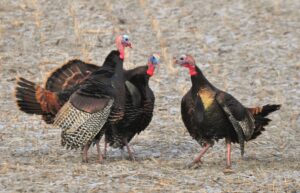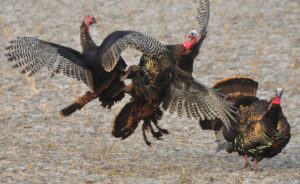Photography courtesy of Lowell Washburn, all rights reserved.
Although Iowa’s spring turkey seasons are still a few weeks away, local gobblers are already strutting their stuff. By the sounds of it, this morning would be no exception. In spite of chilly temperatures and a brisk northwest wind, turkeys had begun sounding off at the first hint of dawn. As daylight increased, the gobbling rapidly intensified. Gliding off the roost, a trio of mature toms touched down near the edge of frost covered bean field.
Quickly merging into a tight group, the birds lost no time in displaying their iridescent finery. With chests puffed, tails fanned and wing tips dragging, each tried to appear larger and more intimidating than the others. Their individual desire for dominance was further displayed by the bright red, white, and blue head colors exhibited by turkeys on the prod. All three of the gobblers were armed with the formidable needle-sharp spurs of a three-year-old bird, making each a potential danger to competing males. Although the daybreak show was high on threats and posturing, the displays were largely benign. A sharp peck on the head, a pulled feather, or an occasional shove was as far as the violence went.

But as the sun neared the horizon, the mood suddenly changed, and it soon became apparent that the toms were becoming increasingly agitated. Raucous gobbling was replaced by the sound of fighting purrs as the shoving matches became more aggressive. No surprise really. The spring breeding season is at hand; and in Turkeydom there can only be one King of the Woodlands.

As the purring birds circled for advantage, one of the toms suddenly lashed out with dagger-like spurs. The move was countered with an instant response as the intended victim deftly sidestepped the attack. Successful or not, the initial contact provided the spark that ignited the flame. The frosty bean field quickly became the stage for a genuine March Smackdown. Simultaneously leaping into the air, the gobblers employed beak, spur, and wings to punish their opponents. Like giant barnyard roosters, the flailing birds leaped into the air time and again. As the battle continued to rage, one of the toms was pushed slightly off balance. His opponent — the bird who had first initiated the combat — lost no time in seizing the moment. Quickly moving to the rear of the faltering tom, the gobbler jumped into the air and coming back down, literally stabbed his rival in the lower back. Backed by twenty plus pounds of muscle and bone, the needle-sharp spurs had a devastating effect. The crushing blow literally drove its victim to the ground. For the recipient of the body slam, the contest was over. Within two or three seconds, the bright red and white head colors of a battling tom were replaced by the pale hues of a total noncombatant. With feathers ruffled, the defeated gobbler limped from the field.
With one down and one to go, the victor quickly turned to square off with the remaining member of the early morning trio. But the third turkey had apparently seen enough. Remaining completely passive, the bird showed no desire to challenge the posturing tom. The decision was final. A new Woodland King had been crowned. The tom announced his victory with a rousing double gobble.


 Tom Cope
Tom Cope Sue Wilkinson
Sue Wilkinson Susan Judkins Josten
Susan Judkins Josten Rudi Roeslein
Rudi Roeslein Elyssa McFarland
Elyssa McFarland Mark Langgin
Mark Langgin Adam Janke
Adam Janke Joe Henry
Joe Henry Kristin Ashenbrenner
Kristin Ashenbrenner Joe Wilkinson
Joe Wilkinson Dr. Tammy Mildenstein
Dr. Tammy Mildenstein Sean McMahon
Sean McMahon